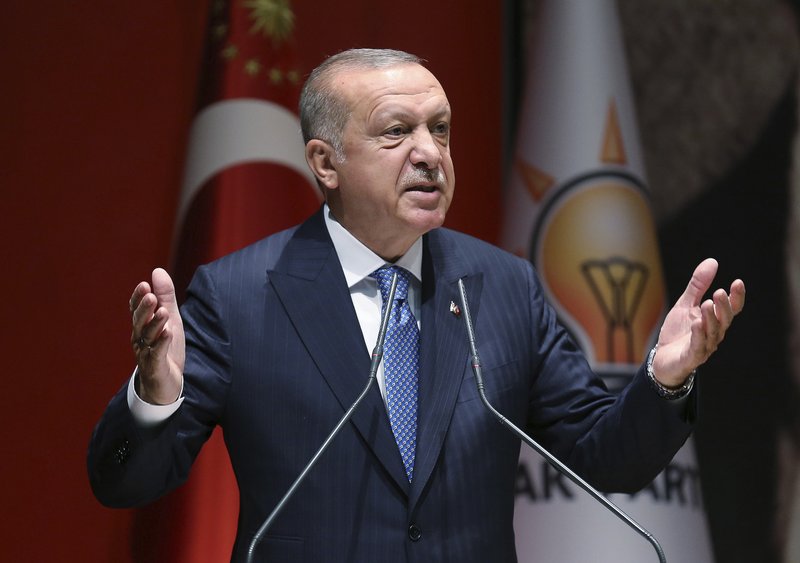WASHINGTON -- The Pentagon is preparing to send about 150 troops to northeastern Syria to conduct ground patrols with Turkish forces, reversing at least temporarily a withdrawal from Syria that President Donald Trump ordered in December.
The new troop deployment, which has not been previously reported, is part of an expanding series of military and diplomatic steps the United States has taken in recent weeks to defuse escalating tensions with Turkey, a NATO ally, over U.S. support for Syrian Kurdish fighters. Those fighters led the ground war against the Islamic State, a shared enemy, but Turkey considers them terrorists.
The United States currently has just under 1,000 troops in Syria, mainly to help stamp out remaining pockets of Islamic State fighters.
Turkey threatened last month to invade northeast Syria to rout the Syrian Kurds from territory along the border they seized from the Islamic State group. In response, the Pentagon in recent weeks has rushed to both set up joint reconnaissance flights and ground patrols with Turkish forces in a narrow buffer zone inside Syria, and destroy Kurdish fortifications near the border that Turkey considered threatening. Two senior American generals met this week with their Turkish counterparts in Ankara, Turkey's capital.
"Turkey could be a spoiler of U.S. policy regarding Iran, Iraq, Syria and ISIS, or it could be a facilitator," said Soner Cagaptay, director of the Turkish Research Program at the Washington Institute for Near East Policy and author of Erdogan's Empire: Turkey and the Politics of the Middle East.
Just as senior American officials expressed cautious optimism that tensions with Turkey were easing, President Recep Tayyip Erdogan upended that calculus with a proposal last week to involuntarily return at least 1 million Syrian refugees now inside Turkey and push them into the buffer zone. If that does not happen, he is threatening to send a flood of Syrian migrants to Europe.
Erdogan has long demanded a buffer zone along Turkey's border with Syria to exclude Kurdish forces. But he has repurposed the idea for a zone as a sanctuary for Syrians fleeing the war. Erdogan's plan prompted strong and immediate criticism from the Pentagon.
"The United States opposes any forced or coerced relocations of refugees or IDPs," said Cmdr. Sean Robertson, a Pentagon spokesman, referring to internally displaced persons typically held in sprawling camps. "If and when conditions allow, any returns must be to a destination of the individual's own choosing, and must be voluntary, safe and dignified."
Erdogan said Saturday that he expected to meet with Trump at the United Nations later this month to discuss military operations in northeast Syria.
American military and diplomatic officials declined to publicly comment on the impending deployment of about 150 troops, the final approval of which still hinges on the success of the initial joint ground patrols that are to continue in the coming days, military officials said.
A senior administration official said last month that the United States "will provide forces necessary" for northeastern Syria, noting that a platoon of a few dozen soldiers now carries out similar patrols with Turkish forces in Manbij, Syria. It was unclear whether the new deployment would increase the overall number of American troops in Syria or be offset by reductions in the existing force there helping directly with counterterrorism missions.
The future of northeastern Syria is just one area in which Turkey and the United States have engaged in contentious discussions.
The White House informed Turkey in July that the United States would not sell it F-35 stealth fighter jets, in retaliation for Turkey's $2.5 billion purchase of Russian S-400 surface-to-air missile systems. The sale also has heightened the possibility of long-threatened U.S. sanctions being imposed against a fellow member of NATO.
The two militaries established a joint operations center in Ankara. They have conducted four joint reconnaissance flights over the area, including one Thursday. And last weekend, American and Turkish troops conducted their first joint ground patrol.
In a sign of how diplomatic sensitivities are affecting the messaging behind these operations, the military's news release about the first ground patrol showed one photograph with a Turkish vehicle in the lead and another with an American vehicle in the lead.
A Section on 09/13/2019
